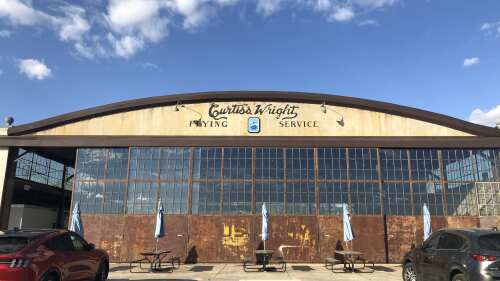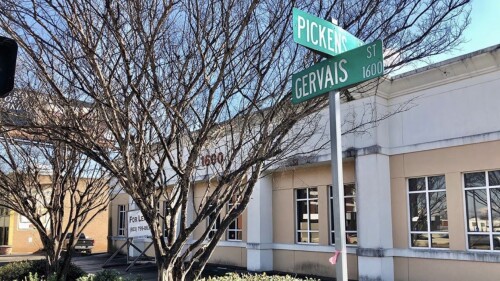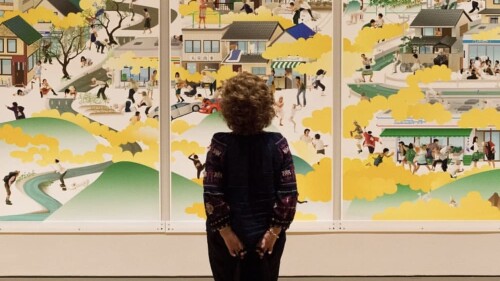8 historic mills in Cola, then and now.
Cruise through downtown Cola and you’ll be able to spot several mills repurposed into bustling mixed-use developments or residential hubs. Columbia’s history as a cotton/textile mill town means there’s a whole lot of character within these properties – and a lot of interest in making sure they remain part of the fabric of the city.
Here are eight historic Columbia mills you’ll want to know about:
Granby + Olympia Mills
📍510 Heyward St.
Then: Granby Mill (est. 1896) + Olympia Mill (est. 1899), were both designed + built by W.B. Smith Whaley & Company – one of South Carolina’s leading, most innovative architecture firms of its time. Granby Mill was the state’s first cotton mill powered by a remote source of hydroelectric power. Olympia Mill, one of four cotton mills in Columbia, was the largest cotton mill in the world, under one roof.

Postcard of Olympia Mill via Souvenir Post Card Company | Image Courtesy of Richland Library
Now: The mills shut down in 1996, then remained vacant until they were transformed into upscale housing for college students + young professional in 2007 – known today as Granby + Olympia Mills Apartments. Both mills are listed in the National Register of Historic Places, and there’s a cool monument dedicated to the old mills + mill workers outside of Olympia.

Olympia Mill | Photo by @grandparich9
Richland Mill
📍211-221 S. Main St.
Then: Built in 1895, Richland Mill (later referred to as Whaley’s Mill) was the first of W.B. Smith Whaley & Company’s mill buildings in Columbia. At 4-stories tall (with a 7-story staircase), and taking up ~4 acres, it stood as a focal point of the city’s bustling cotton textile industry. An engine room, boiler room + a machine shop were added to the mill shortly after initial construction.
Now: Richland Mill is now on-campus student housing, The Lofts at USC. It was listed in the National Register of Historic Places in 1983.

The Lofts at USC | Photo by @chelsee_shortt

Inside of The Lofts at USC | Photo by @mackwillly
The above-mentioned mills [Olympia, Granby, Richland + the SCE&G owned Capital City Mill] were all owned by Mr. Whaley and known as The Whaley Mills – or Columbia’s mill village – which the community residents (mill workers + their families) called a utopia, because it had it all: a store, community center, schools, a swimming pool, churches, baseball fields + free living in “saltbox” houses (simplistic, wooden, farmhouse-type homes) for all the mill workers. Fun fact: Jaco’s Corner, built in 1909, was originally a saltbox house of the mill village.
W.B. Smith Whaley ran up his debts over the years, and eventually lost all the mills in 1903. In 1915, Massachusetts-based Pacific Mills purchased the mill village for $3.5 million, maintaining them + the community as Waley did, until the Great Depression hit in the 1930s.
Palmetto Cotton Mill
📍617 Devine St.
Then: The oldest part of the Palmetto Cotton Mill dates back to 1917. It was initially built as a short-term cotton storage facility – storing 50,000+ bales of cotton at its peak. It’s 1 of 4 surviving cotton compress facilities in the Southeast + one of the largest cotton warehouses in S.C. In 2012, the building faced demolition due to its “impossible” size, location, sloped floors, etc. In 2013, it was sold to City of Columbia for $5.6 million.
Now: The building is now owned by PMC Property Group was was transformed into a combo of high-end apartments + retail space, called Palmetto Compress – with all the existing framework still intact. It was added to the National Register of Historic Places in 1985 + was a Historic Columbia 2017 Preservation Award winner – recognized for its its adaptive use (a.k.a. early 20th century warehouse turned retro-living + retail).
Columbia Mills
📍301 Gervais St.
Then: Built in 1893, the Columbia Mills – which specialized in creating duck (a heavy-duty material used for things like belts, tents + sailcloths) are believed to be the first mills in the world operated by electricity. The mill village, Aretasville (named after the president of Columbia Mills), was created for its employees in West Columbia. In 1899, Baltimore-based company Mount Vernon–Woodberry Cotton Duck Company purchased Columbia Mills – changing its name to Mt. Vernon/Columbia Duck Mill. The mill stayed in operation (with 1,200 employees) until 1981 – before moving to a smaller location, and donating the mill building to the state.

Columbia Duck Mill | Image courtesy Richland Library
Now: In the late 1980s, Columbia Mills was transformed into what we now know as the South Carolina State Museum (SCSM) – the largest museum in the state. It was added to the National Register of Historic Places in 1982. SCSM was was also a Historic Columbia 2015 Preservation Award winner + an American Institute of Architects South Carolina Design Award winner, to name a few.

South Carolina State Museum | Photo by @robertcarter
Glencoe Mills
📍929 Huger St.
Then: Built in 1910 + located in Columbia’s warehouse district, Glencoe Mills was the 7th cotton mill in Cola, specializing in producing cotton twine. Glencoe Mills employees + their families all lived on the 6-acre plot where the mill was located – which included churches, stores and other buildings that met the needs of the community. After hardships of the Great Depression + collecting a significant amount of debt, Glencoe Mills shutdown in March 1939. In September 1939, the property was divided into several lots (32 buildings spanning the 900 block of Huger St.) + sold at a public auction.
Now: Over the years, buildings of Glencoe Mills have been everything from furniture stores to office supply warehouses – which have gotten rid of other smaller mill buildings to meet their development needs. Today, the only building still standing from Glencoe Mills is the main mill building, and it now houses Copper Horse Distilling.

Inside of Copper Horse Distilling | Photo by @copperhorsedistilling
Adluh Flour Mills
📍804 Gervais St.
Then: Built in 1900, Adluh Flour Mill – the only historic S.C. flour mill still in operation – produces flour + cornmeal products, creating specialty grits items by stone (a process they still use today). The mill was originally owned + operated by B.R. Crooner and family – until it merged with the Columbia Grain and Provision Co, owned by J. H. Hardin. Both families co-owned + operated the business until it went into foreclosure, and First Commercial National Bank took over. The Allen family purchased the mill from the bank in 1926, and still operates it today.
Now: Today, the Allen family operates Adluh under the name Allen Brothers Milling. It’s the nation’s second oldest continuously-operated electric flour mill – producing 50,000+ lbs. of flour, 25,000 lbs. of cornmeal + 6,000 lbs. of grits each day. Adluh Flour supplies many of Cola’s restaurants with their products, like Motor Supply, Blue Marlin + Lizards Thicket.

Photo by @ircodavid
TBH, I’m fascinated by all of this mill history in our city. Imagining downtown Columbia divided up into all these little mill villages is so wild. Our local mills finding new life – and one even remaining the same all these years – means that instead of forgetting the past, they are part of the conversation as our city continues to grow + transform.
Also, a special thanks to our fav #TBT Historic Columbia writer, Lois, for helping me gather all the information.
–Sam














